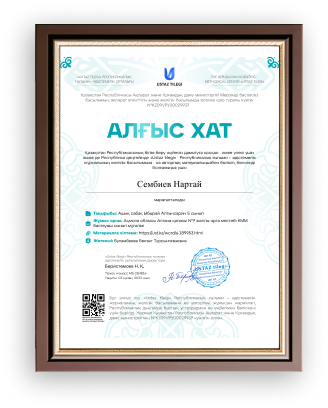
Lesson plan
|
Long term plan module: |
School: №11 |
|||||
|
Date: |
English teacher: Turganbaeva Zh |
|||||
|
Class: |
Number of present: |
Absent: - |
||||
|
Learning objective(s) that this lesson is contributing to: |
1.L3 recognize with support common names and names of places; 1.S4 respond to basic supported questions about people, objects and classroom routines 1.S3 pronounce familiar words and expressions intelligibly 1.UE4 use determiners a, an, some, the, this, these to indicate what /where something is |
|||||
|
Lesson objectives: |
All learners will be able to: pronounce topic words and expressions intelligibly. |
|||||
|
Most learners will be able to: listen and sing along to the Animal song and dance to music. |
||||||
|
Some learners will be able to: draw a picture of an animal from his/her country and present it to the class, using topic words; |
||||||
|
Language objectives: |
Learners can: By the end of the lesson learners will be able to - draw a picture of an animal from his/her country and present it to the class, using topic words; - pronounce topic words and expressions intelligibly |
|||||
|
Key words and phrases Wild animals: elephant, zebra, lion, panda, kangaroo Pets: mouse, dog, rabbit, parrot, fish I’m Jenny. My favourite animal is the kangaroo. I’m …... My favourite animal is the …. . |
||||||
|
Useful classroom language for dialogue/writing: oral |
||||||
|
Discussion points: |
||||||
|
Can you say why you like to keep pets? |
||||||
|
Writing prompts: |
||||||
|
Assessment for Teaching |
Criteria based assessment Assessment criteria: Presenting his/her favourite animal to class in statements correctly. Descriptor: A learner draw a picture of an animal from his/her country and present it to the class. using topic words; pronounces topic words and expressions intelligibly Technique of FA: Oral feedback |
|||||
|
How to overcome barriers in learning English |
-Use video lesson -Get learners to think before answering -Get learners to think before answering -Challenge and extend learners through carefully scaffolding assignments and activities |
|||||
|
Previous learning |
Lesson32 Project time |
|||||
|
Lesson Plan |
||||||
|
Planned timing |
Planned activities (replace the notes below with your planned activities) What will the pupils learn? How will they learn it? Suggested Teaching Activities Active Learning activities |
Resources |
||||
|
Start (Beginning of the lesson) |
Greeting: Teacher teaches the learners to greet one another in English; learners respond to greeting of the teacher and take their places. Dividing into subgroups using colourful stickers Warming up: Act out the situation in the picture. Use greetings and goodbye words: Hello, hi, good morning, good afternoon, good bye, nice to meet you, see you. How do you think what theme we have for today? Teacher asks the learners to identify today’s theme using mimics and gestures. Teacher introduces lesson objectives to the learners. |
colourful stickers |
||||
|
Middle (of the lesson) |
D) Teacher presents the words using flashcards, pictures, mime and gestures: parrot, panda, zebra, fish, dog, lion, mouse, hare, and elephant. In feedback learners name the toys, looking at the pictures, mimes and gestures. I) Teacher gives out a worksheet with wild animals and pets to every learner. Ask the learners to point, colour wild animals green and pets red. They are asked to say, using phrase: Wild animals are zebra, lion, horse …. Pets are parrot, hare, fish…. P) Each pair is given three pictures: a kangaroo, a panda and a horse. Teacher reads presentations of three boys from three countries: the UK, Kazakhstan and China. Every time the teacher reads sentences of this or that boy, learners must show the picture which is appropriate to the presentation. Example: I am Jenny. My favourite animal is the kangaroo. I) Draw a picture of an animal from your country and present it to the class. Example: I am Maksat . My favourite animal is the sheep. W) The whole class listens and sings along to the Animal song. Learners dance to music. |
Song: Animals , CD, DVD players, picture dictionaries, toys, grammar cards, a worksheet Student’s book1, Activity Book 1 |
||||
|
End (of the lesson) |
Reflection Self-assessment: Hand signals Technique of FA: Oral feedback Ask students to look at lesson objectives they set at the beginning of the lesson and think and say what they did well in the lesson and what needs improvement. |
|
||||
|
Additional information: |
||||||
|
Differentiation - how do you plan to give more support? How do you plan to challenge the more able learners? |
Assessment - how are you planning to check learners’ learning? |
Cross – curricular links health and safety check ICT links Values links |
||||
|
|
|
|
||||
|
Reflection Were the lesson objectives / learning objectives realistic? What did the learners learn today? What was the learning atmosphere like? Did my planned differentiation work well? Did I stick to timings? What changes did I make from my plan and why? |
Use the space below to reflect on your lesson. Answer the most relevant questions from the books on the left about your lesson. |
|||||
|
Summary evaluation What two things went really well (consider both teaching and learning)? 1. 2. What two things would have improved the lessons (consider both teachings and learning)?
|
||||||
жүктеу мүмкіндігіне ие боласыз
Бұл материал сайт қолданушысы жариялаған. Материалдың ішінде жазылған барлық ақпаратқа жауапкершілікті жариялаған қолданушы жауап береді. Ұстаз тілегі тек ақпаратты таратуға қолдау көрсетеді. Егер материал сіздің авторлық құқығыңызды бұзған болса немесе басқа да себептермен сайттан өшіру керек деп ойласаңыз осында жазыңыз
Times of my day
Times of my day
Lesson plan
|
Long term plan module: |
School: №11 |
|||||
|
Date: |
English teacher: Turganbaeva Zh |
|||||
|
Class: |
Number of present: |
Absent: - |
||||
|
Learning objective(s) that this lesson is contributing to: |
1.L3 recognize with support common names and names of places; 1.S4 respond to basic supported questions about people, objects and classroom routines 1.S3 pronounce familiar words and expressions intelligibly 1.UE4 use determiners a, an, some, the, this, these to indicate what /where something is |
|||||
|
Lesson objectives: |
All learners will be able to: pronounce topic words and expressions intelligibly. |
|||||
|
Most learners will be able to: listen and sing along to the Animal song and dance to music. |
||||||
|
Some learners will be able to: draw a picture of an animal from his/her country and present it to the class, using topic words; |
||||||
|
Language objectives: |
Learners can: By the end of the lesson learners will be able to - draw a picture of an animal from his/her country and present it to the class, using topic words; - pronounce topic words and expressions intelligibly |
|||||
|
Key words and phrases Wild animals: elephant, zebra, lion, panda, kangaroo Pets: mouse, dog, rabbit, parrot, fish I’m Jenny. My favourite animal is the kangaroo. I’m …... My favourite animal is the …. . |
||||||
|
Useful classroom language for dialogue/writing: oral |
||||||
|
Discussion points: |
||||||
|
Can you say why you like to keep pets? |
||||||
|
Writing prompts: |
||||||
|
Assessment for Teaching |
Criteria based assessment Assessment criteria: Presenting his/her favourite animal to class in statements correctly. Descriptor: A learner draw a picture of an animal from his/her country and present it to the class. using topic words; pronounces topic words and expressions intelligibly Technique of FA: Oral feedback |
|||||
|
How to overcome barriers in learning English |
-Use video lesson -Get learners to think before answering -Get learners to think before answering -Challenge and extend learners through carefully scaffolding assignments and activities |
|||||
|
Previous learning |
Lesson32 Project time |
|||||
|
Lesson Plan |
||||||
|
Planned timing |
Planned activities (replace the notes below with your planned activities) What will the pupils learn? How will they learn it? Suggested Teaching Activities Active Learning activities |
Resources |
||||
|
Start (Beginning of the lesson) |
Greeting: Teacher teaches the learners to greet one another in English; learners respond to greeting of the teacher and take their places. Dividing into subgroups using colourful stickers Warming up: Act out the situation in the picture. Use greetings and goodbye words: Hello, hi, good morning, good afternoon, good bye, nice to meet you, see you. How do you think what theme we have for today? Teacher asks the learners to identify today’s theme using mimics and gestures. Teacher introduces lesson objectives to the learners. |
colourful stickers |
||||
|
Middle (of the lesson) |
D) Teacher presents the words using flashcards, pictures, mime and gestures: parrot, panda, zebra, fish, dog, lion, mouse, hare, and elephant. In feedback learners name the toys, looking at the pictures, mimes and gestures. I) Teacher gives out a worksheet with wild animals and pets to every learner. Ask the learners to point, colour wild animals green and pets red. They are asked to say, using phrase: Wild animals are zebra, lion, horse …. Pets are parrot, hare, fish…. P) Each pair is given three pictures: a kangaroo, a panda and a horse. Teacher reads presentations of three boys from three countries: the UK, Kazakhstan and China. Every time the teacher reads sentences of this or that boy, learners must show the picture which is appropriate to the presentation. Example: I am Jenny. My favourite animal is the kangaroo. I) Draw a picture of an animal from your country and present it to the class. Example: I am Maksat . My favourite animal is the sheep. W) The whole class listens and sings along to the Animal song. Learners dance to music. |
Song: Animals , CD, DVD players, picture dictionaries, toys, grammar cards, a worksheet Student’s book1, Activity Book 1 |
||||
|
End (of the lesson) |
Reflection Self-assessment: Hand signals Technique of FA: Oral feedback Ask students to look at lesson objectives they set at the beginning of the lesson and think and say what they did well in the lesson and what needs improvement. |
|
||||
|
Additional information: |
||||||
|
Differentiation - how do you plan to give more support? How do you plan to challenge the more able learners? |
Assessment - how are you planning to check learners’ learning? |
Cross – curricular links health and safety check ICT links Values links |
||||
|
|
|
|
||||
|
Reflection Were the lesson objectives / learning objectives realistic? What did the learners learn today? What was the learning atmosphere like? Did my planned differentiation work well? Did I stick to timings? What changes did I make from my plan and why? |
Use the space below to reflect on your lesson. Answer the most relevant questions from the books on the left about your lesson. |
|||||
|
Summary evaluation What two things went really well (consider both teaching and learning)? 1. 2. What two things would have improved the lessons (consider both teachings and learning)?
|
||||||

шағым қалдыра аласыз















